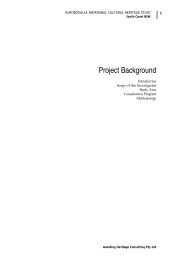Eurobodalla Integrated Water Cycle Management Strategy
Eurobodalla Integrated Water Cycle Management Strategy
Eurobodalla Integrated Water Cycle Management Strategy
You also want an ePaper? Increase the reach of your titles
YUMPU automatically turns print PDFs into web optimized ePapers that Google loves.
<strong>Eurobodalla</strong> <strong>Integrated</strong> <strong>Water</strong> <strong>Cycle</strong> <strong>Management</strong> <strong>Strategy</strong><br />
pumping effectively reduces the security of supply resulting in more frequent restrictions<br />
than predicted (3 times in the past 15 years compared with modelling parameters of 10<br />
restrictions every 100 years). A filtration plant would eliminate the need for turbidity limit on<br />
run-of-river pumping and would restore the original secure yield under the current licence<br />
conditions. The current licence condition allows all the water available at the intakes to be<br />
extracted to meet the urban demands. As a result there is no explicit protection of the<br />
downstream environment and water users particularly during low flow periods. However, in<br />
recognition of the social and environmental values, Council generally tends to cease<br />
pumping when flows in the rivers are low. This has also contributed to lower supply security<br />
and more frequent restrictions than the model suggests, which is based only on the licence<br />
condition.<br />
Current Security of Supply Status<br />
Figure 6-17 shows that the secure yield of the existing scheme based on the current licence<br />
conditions is about 8 200 ML/a. Based on population projections, the existing system of<br />
source infrastructure is adequate to supply demand for the next 40+ years. However, due to<br />
Council’s operating strategy, which limits extraction when the river water is turbid and<br />
protects low flows by ceasing to pump, the actual secure yield is likely to be substantially<br />
less. Due to the lack of operational turbidity data the secure yield based on the current<br />
operational strategy cannot be accurately quantified at this stage.<br />
Whilst the above observations are based on system modelling outcomes, in the<br />
development of the model care has been taken to ensure that it represents the actual<br />
situation as far as practical. There are still areas of uncertainty, and in developing the model<br />
the following assumptions have been made:<br />
Extraction is not constrained by water quality of the supply sources (e.g. turbidity)<br />
The accuracy of the system modelling outcome is limited by the extent and<br />
accuracy of the last 104 years of historic stream flow and rainfall data used<br />
Any changes to catchment land use and irrigation practices will not significantly<br />
alter the stream flow sequence<br />
Future climate will be statistically similar to the observed historic climate<br />
Future urban water use pattern will be statistically similar to observed historic usage<br />
patterns and that the current legislation and community ‘consciousness and<br />
awareness’ on conservation will continue<br />
The population of <strong>Eurobodalla</strong> will continue to increase albeit at a slower rate than<br />
in the past and that it will remain a popular tourist and holiday destination.<br />
Environmental Flow and Access Sharing<br />
As discussed in section 6.1.1, the <strong>Water</strong> <strong>Management</strong> Act will affect how much water is<br />
available for harvesting during low flow periods. Leaving water for the river environment will<br />
improve the environmental health and the long term sustainability of the river, however it<br />
also reduces the secure yield of the water supply system. The quantity of water required for<br />
the environmental flows has yet to be decided by the water management committees. At<br />
the inter-agency meeting (October 2002) it was agreed that the future planning should<br />
consider the following cease to pump and flow access conditions as the base level cases<br />
for the three supply sources:<br />
Within the first 10 year cycle of the water sharing plan, cease to pump when<br />
Moruya, Tuross and Buckenboura Rivers flow drops below 12 ML/d, 17 ML/d and<br />
1 ML/d respectively at the water supply intake (95 th percentile).<br />
55

















